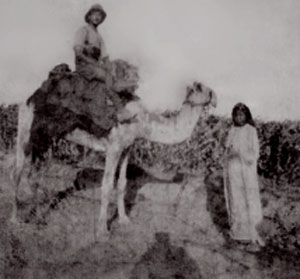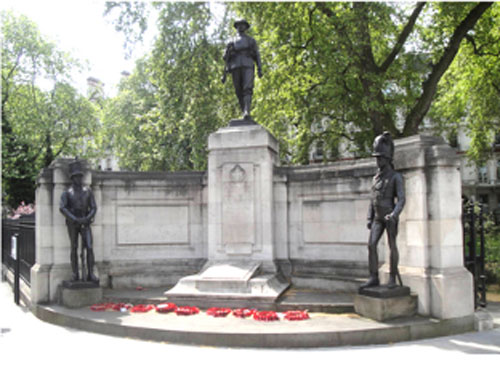
Samuel K. Gothard Photograph Courtesy of Susan Gothard
20th Rifle Brigade (formerly service number 340)
Samuel Kirkwood Gothard was born on 5th February1873 in the Gothard family home on Bradford Road, Dewsbury. Samuel was the son of Ossett born John Gothard, an iron moulder, and Mansfield born Sarah Ann (late Simpson, formerly Kirkwood).
Both John Gothard (1816–1889) and Sarah Ann Kirkwood (1838-1898) had previous relationships. John’s first wife was Ann Archer (1817-1871), married in spring 1842 but died in early 1871. The couple had three children. Sarah Ann Kirkwood’s relationship with a man named Simpson is not found.
John had his second relationship (a formal marriage not being found) with Sarah Ann Kirkwood. In 1871 the couple were living in Heckmondwike with the two of the children from John’s first marriage. John and Sarah Ann had a child, Eliza Ann, aged 4 months.
By 1873 the family had left Heckmondwike to live on Bradford Road, Dewsbury where the couple’s second and final child, Samuel Kirkwood Gothard, was born. In 1881 the family were living at Battye Street, Dewsbury. Sadly Samuel’s father, John, died in summer 1889, aged 72 years old leaving 51 years old Sarah Ann a widow with two children, Eliza Ann and Samuel aged 18 and 16 respectively. By 1891 she had moved with her two children to live on Dewsbury Road Ossett; Eliza Ann worked as rag sorter and Samuel was a miner. By 1895 the family moved to the other side of Ossett at Chapel Street in South Ossett and in August 1896, Samuel’s sister, Eliza Ann of The Common Ossett, was married at Christ Church, South Ossett to Alfred Lamb of Ossett Spa. Eliza Ann made her mark on the marriage registration. The couple lived at 26 Hall Cliffe, Horbury by 1911 and they had two surviving children, aged 5 and 7 years, born in Horbury.
Sadly Samuel’s mother Sarah Ann died in summer 1898 aged 59 years. On 2nd September 1899 at Dewsbury Register Office, Samuel Kirkwood Gothard, an iron forgeman of Chapel Street Ossett married machinist Gertrude Rachel Harwood Margetts, of Healey Road, Ossett. Gertrude Rachel’s Oxfordshire parents and her siblings had moved to Healey Lane, Ossett in the mid 1890’s. Samuel and Gertrude made their home at Turn O’ The Nook off Wesley Street and Samuel worked as an iron forgeman. By 1911 the couple were living with their children at the two roomed Sutcliffe’s Yard at 1, The Green. Including a child born after 1911 the couple had six surviving children of nine born to the marriage.
Samuel was 41 years of age in 1914 when Germany’s army crossed into neutral Belgium in order to reach Paris, forcing Britain to declare war with Germany (due to the Treaty of London (1839) whereby Britain agreed to defend Belgium in the event of invasion). By the 4th August 1914 Britain and much of Europe were pulled into a war which would last 1,566 days, cost 8,528,831 lives and 28,938,073 casualties or missing on both sides.
Samuel’s Army Service Record was destroyed in a Luftwaffe attack on London in September 1940 which makes it more difficult to be certain about his whereabouts in WWI. At this stage in the war the upper age limit for service in WWI was 41 years and consequently it is likely that he voluntarily enlisted before the date of his 42nd birthday on 4th February 1915.
Samuel would then have had a period of training at Denham Camp alongside men of the Northumberland Fusiliers, Durham Light Infantry, East Yorkshire Regiment, West Yorkshire Regiment and Durham R.G.A. who subsequently formed the Territorial Force 20th (Northern) Rifle Brigade on 28th November 1915.
His medal index card records two service numbers viz; 340 and 202422. The first service number (340) may have been given by the formative 20th Rifle Brigade or by one of the above constituent regiments on enlistment. The second service number (202422) was from the band 200001-300000 allotted to some of the Rifle Brigade battalions (including the 20th battalion) in March 1917.
Because Samuel was not awarded the 1914-15 Star medal it is known that he did not serve overseas in 1915. He entered his first theatre of war, when serving with a contingent of 932 soldiers of the 20th (Northern) Rifle Brigade which embarked for Egypt aboard RMS Olympic or SS Grampian disembarking at Alexandria on 16th January 1916. The battalions comprising the Brigade were used for garrison duty of vulnerable points in Egypt and Palestine.
[ RMS Olympic, a sister ship of the fated Titanic, was requisitioned by the Admiralty in May 1915 as a troop transport and SS Grampian which remained in commercial service, but carried members of the Canadian Expeditionary Force from Canada to Europe. After being dismantled in the late 1930’s some of the fittings of the Olympic were auctioned off. The fittings of the first-class lounge and part of the aft grand staircase can be found in the White Swan Hotel, in Alnwick, Northumberland]
In January 1916 H.Q. were at Benha with one company at Birket-el-Saba. On the last day of February they moved to Abbasia with two companies guarding prisoners at Maadi and in July took over the duties of the 21st Rifle Brigade. Early in 1917 they moved back to Benha and Tanta and in July of that year had two companies at Belbeis. The diary shows a marked absence of crime and court martials. In March 1918 their Colonel was mentioned in Despatches, and in the same year the Battalion provided a Guard-of-Honour to H.R.H. Duke of Connaught.
 Photo; Courtesy of Susan Gothard
Photo; Courtesy of Susan Gothard
Samuel on a camel in Egypt 1916-1919
There were no further incidents in their history and by February 1919 demobilisation had reduced the Battalion strength from about 600 to 328. They moved to Alexandria at this time and took over duties at the docks from 2nd Garrison Battalion Royal Welch Fusiliers. The Battalion lingered on with a strength of under 100 until 4th August 1919, when they were finally disbanded and the nineteen survivors absorbed by 12th Battalion The Hampshire Regiment.
Samuel wouldn’t have seen much of this run down of the Brigade as his tour of duty was completed on 17th January 1919 by demobilisation or discharge for medical reasons or by reason of his age. It was exactly three years after he disembarked at Alexandria, Egypt. The Rifles Brigade formed a total of 28 battalions during the First World War, in addition to the pre-war establishment of two Regular and two Militia and two Territorial Battalions. The regiment lost 11,575 men who were killed during the course of the war and were awarded 52 battle honours including 10 Victoria Crosses.
Samuel returned to his Ossett home and his family at Ward’s Buildings, Healey Road and on 9th August 1920, some 20 months after his demobilisation/discharge there was evidence from a pension card that he had contracted a 60% unspecified disability for which he was awarded an allowance for a 12 months period commencing July 1920. Sadly, just four months later he died in Clayton Hospital Wakefield on 12th November 1920, aged 48 years. A little later Samuel was posthumously awarded the British and Victory medals for his army service.
The cause of Samuel’s death was “(1) Chronic Nephritis 1 year (2) Acute Nephritis 2 days. No P.M.” The Death Certificate records his age at death as 48 years, whereas was 47 years.
On 17th November 1920 his widow was awarded a pension and each of his five surviving children were awarded an allowance to expire on their 16th birthday.
When Samuel’s case was brought to the attention of The Ossett Fallen Team (the Team) the Commonwealth War Graves Commission (CWGC) had not commemorated him. The reason for a non – commemoration was unclear and in mid – December 2021 the Team put forward an application in support of his commemoration.
This was necessary because the Team considered that there was evidence that his death was attributable or aggravated by WAR Service. Expert opinion in these circumstances is only available from CWGC and indeed is one of the necessary requirements to maintain the WAR Memorial’s integrity when considering a nomination of a name to be inscribed there. The grant of a CWGC Commemoration can be supported by a CWGC Headstone at the grave of the serviceman/woman. Without a CWGC Commemoration the CWGC Headstone would not be possible.
In November 2022 the Commonwealth War Graves Commission (CWGC) accepted our December 2021 submission and confirmed that Samuel Kirkwood Gothard had been accepted for commemoration following an adjudication decision from the military service authorities. In March 2023, CWGC also confirmed that, subject to the family’s consent, a Commission headstone will be installed at Samuel’s burial location to mark his place of rest at St. John’s Methodist Chapelyard (Row 38. Grave 23).
Samuel (1873-1920) shares the grave at St. John’s with his wife, Gertrude Rachel Gothard (1875-1927). Whilst awaiting the arrival of a CWGC Headstone, Susan Gothard, a relative of Samuel, and her partner Bryan Coe located and attended the grave; a plaque was placed there in memory of Samuel and Gertrude. We are most grateful for Susan and Bryan’s support and assistance in our joint discussions with the Commonwealth War Graves Commission.
The grave of Samuel & Gertrude Gothard at St. John’s following Susan & Bryan’s improvements.
And then, after two years of campaigning by the Team and the family, on 3rd November 2023 at St. John’s Methodist Chapelyard, South Parade, Ossett, the Commonwealth War Graves Commission erected a Headstone in memory of Rifleman Samuel Kirkwood Gothard, The Rifle Brigade.
 Commonwealth War Graves Commission Headstone 3rd November 2023
Commonwealth War Graves Commission Headstone 3rd November 2023
Rifleman Samuel Kirkwood Gothard is also remembered at The Rifle Brigade Memorial, Grosvenor Gardens and Hobart Place, London
 Photograph courtesy Robert Freidus & https://victorianweb.org/sculpture/tweed/7.html
Photograph courtesy Robert Freidus & https://victorianweb.org/sculpture/tweed/7.html
References
Research by Ossett Fallen Team 2023. Biography by Alan Howe.
The Great Forum https://www.greatwarforum.org/
Commonwealth War Graves Commission
https://www.cwgc.org/find-records/find-war-dead/casualty-details/75469813/samuel-kirkwood-gothard/